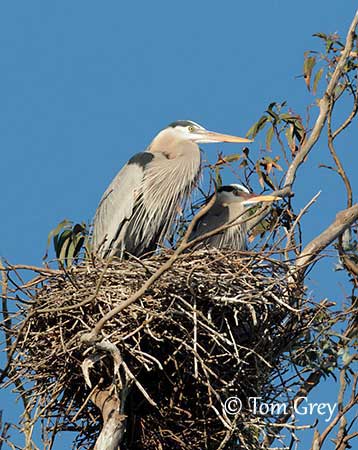
TO BE CONTINUED... Page 5
Text by Nicole Bouglouan
Photographers :
Didier Buysse
Vision d’Oiseaux
Jean Michel Fenerole
Photos d’Oiseaux du monde
Steve Garvie
RAINBIRDER Photo galleries & Flickr Rainbirder
Tom Grey
Tom Grey's Bird Pictures & Tom Grey's Bird Pictures 2
Tom Merigan
Tom Merigan’s Photo Galleries
William Price
PBase-tereksandpiper & Flickr William Price
Callie de Wet
Nature Images by Callie de Wet
Nicole Bouglouan
Photographic ramble & My pictures on IBC
These images and the text are subject to copyright and cannot be used without express authorization from the owners. Legal issues
Sources :
L’ENCYCLOPEDIE MONDIALE DES OISEAUX - Dr Christopher M. Perrins - BORDAS - ISBN: 2040185607
Wikipedia, the free encyclopaedia
Bird nests: Variety is Key for the world’s avian Architects
Be on the lookout for bird nests
The design and function of birds' nests
The bird and its nest, where everything starts…
Page 4 : Ardeidae, Scopidae, Ciconiidae, Balaenicipitidae, Threskiornithidae
At the beginning of the breeding season and following several courtship displays, the nest-site is selected by the pair, or one of the members of the pair, and the nest is built within this area. For numerous species, the nest is the place where displays and copulation occur. It plays a very important role during the nesting period. It is the cradle of the chicks, the place where the adults feed them prior to their first flight towards independence.
The following families are close to the previous. They usually nest close to the water, in trees or aquatic vegetation, except for the Shoebill that nests on the ground, but its large size may explain its nesting behaviour. The other species nest sometimes in small, loose colonies established in trees or on rocky ledges in cliffs like the Northern Bald Ibis.
The Ardeidae lay their eggs in stick nests. Once the pair is formed, both mates build the nest where copulation takes place. This is usually a platform made with sticks, rushes and reeds, and other plant matter found in the area. This rather flimsy structure is often placed in trees, bushes or reeds.
Some species nests in large mixed colonies of up to thousands of nests, whereas others breed in smaller colonies and even in small groups.
Depending on the habitat, the same species may be solitary nester or colonial nester. But tiger-herons and bitterns are generally more solitary than other herons.
The Botaurus species usually nest in reedbeds and build a floating platform. Their cryptic plumage allows them to be almost invisible.

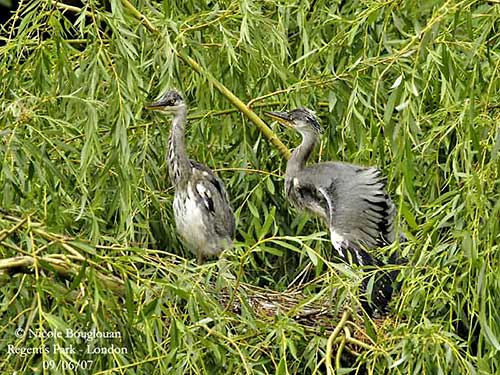
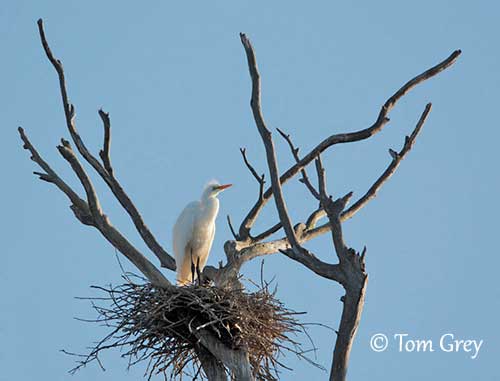
All species nest near water at variable heights above the ground, from low level in reedbeds to 20-30 metres in trees. The Ardeidae which breed in reedbeds or other marsh vegetation build their nests low near the water. However, the species that nests in trees build the nest fairly high above the ground.
Several large species reuse the nest year after year, and the platform may become huge.
The Hamerkop is an aquatic bird. It frequents a wide variety of shallow waters and can be found on lake shores, in marshes, and well vegetated rocky wades with slowly-running waters, from 300 to 3000 metres.
It builds a bulky nest often housing several generations of Hamerkops or other animals such as bees, mongooses, lizards and snakes. These domed nests are among the most extraordinary constructions made by birds. A pair may build several nests within its territory, some of which are never used.
It may size 2 metres wide and height, and 25 to 50 kg weight. They need about six weeks or more to build this enormous nest made with twigs, sticks, reeds, grasses and stems of aquatic vegetation. The nest-chamber is lined with clay and mud, but also with waterweeds and dry grasses. There is a burrow-shaped entrance hall on one side, which opening is reduced with mud. The nest is located in a tree fork near water, on a cliff or on the ground. This huge structure is usually decorated outside with bright-coloured objects and unusual materials.
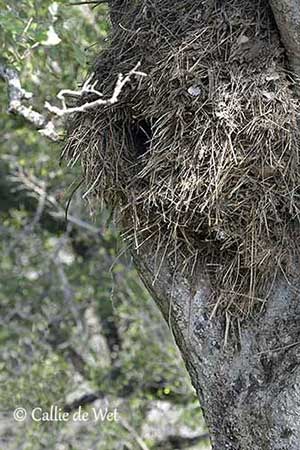
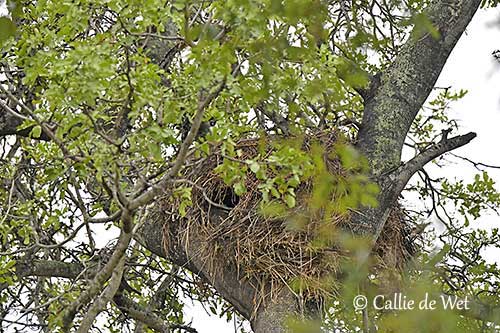
The storks of the family Ciconidae are medium-sized to very large birds. These large birds often nest in trees and need at least some thickets or scattered trees in their preferred habitats, but the European White Stork can also nest on roofs of buildings, as the Abdim’s Stork which makes the nest in the roofs of native huts in Africa, but also on rocky islands and in dry uplands. The latter species is the only truly colonial breeder in the genus Ciconia.
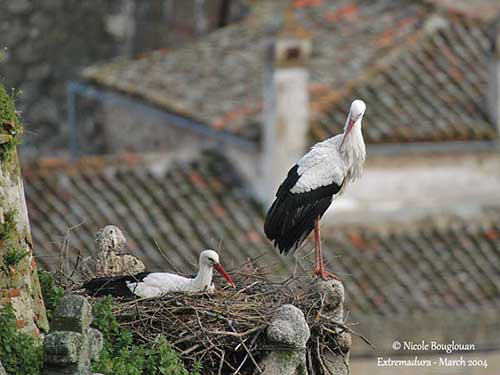
The Black Stork nests in fairly dense forest or on cliff ledges in Spain, whereas the Maguari Stork from South America is the only stork that nests on flat ground and often in reedbeds in marshy area. However, it also nests in trees or bushes elsewhere, depending on the habitat.

The Marabou Stork often nests in tall trees between 10 and 30 metres above the ground. However, it may nest on cliffs (Zambia) and sometimes on buildings in towns and villages.
The nest is built by both adults with sticks. It is lined with twigs and green leaves.
The Painted Stork nests in colonies usually established on several trees often over water. The colonies may include 70-100 nests often very close to each other. The nest is a platform made with sticks, with a lining of softer vegetation.
The Yellow-billed Stork nests in mixed-species colonies established in trees with herons and other aquatic species. The colonies usually include 10-20 pairs, occasionally more, up to 50 pairs with nest 1-3 metres apart.
Both adults build a smallish nest, high up in trees such as Acacia, Bombax or Baobabs, sometimes over water.
But both Yellow-billed Stork in West Africa and Painted Stork in parts of India may nest sometimes in towns.
The Jabiru is a solitary nester or breeds in small colonies of 5-6 nests together. The huge nest is built at treetop, often palm tree.
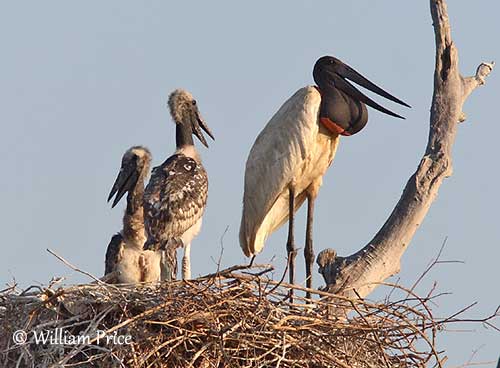
The nests are largely made with sticks but other plant matter is also used. Some species add a soft lining inside. The male may sometimes bring a green leafy twig as definitive decoration!
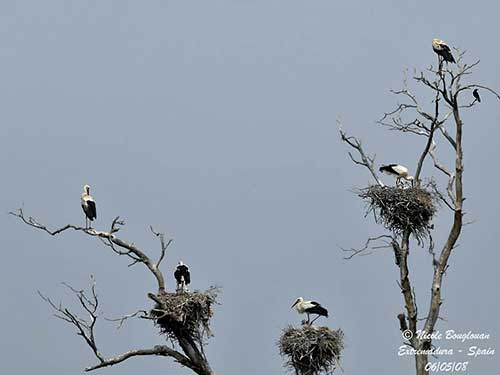
The Shoebill is a unique bird of uncertain affinities with its prehistoric looking. It is found in large reed swamps and extensive papyrus grass, and also in flooded marshes with floating vegetation, but it prefers papyrus.
It is solitary nester and the pair occupies large territories of several square km, and defends a wide territory around the nest-site. Both adults build the nest, preparing first a floating platform of up to 2,5 to 3 metres across. Then, they build the nest of about 1,4 metre of diameter.
Sometimes, the nest is built on termite mounds. The birds work plant stems into the nest by jumping on them for flattening them, and poking them into the nest with their feet.
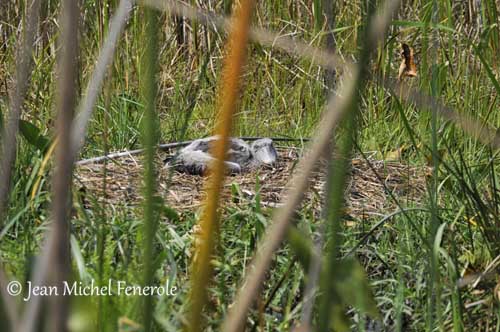
Chick at nest
Ibises and spoonbills differ by their bills. Ibises have a long, narrow, decurved bill, whereas spoonbills have a long, wide bill with flattened tip.
Most of them nest in dense colonies, often with other waterbirds including herons, storks, cormorants or darters. The nests are only 15 cm apart.
The colonies are established in trees, bushes or low vegetation, and sometimes on the ground, especially on islands.
Some species nest in rocky cliffs or in piles of boulders, in small colonies or alone. This is the case of the Northern Bald Ibis.
Others species that live in forests are solitary nesters. This is the case of the Madagascar Crested Ibis.
On the other hand, most spoonbills nest in large mixed colonies of several thousands of pairs. However, the Yellow-billed Spoonbill nests alone or semi-colonially with nests at least 30 metres apart.
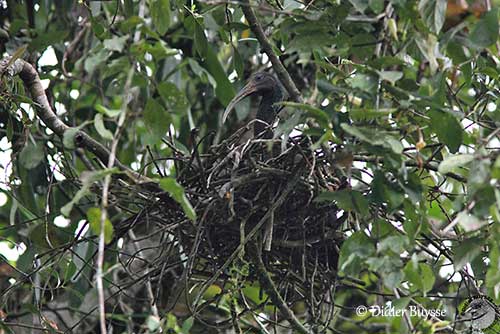
Nest entrance
Nest